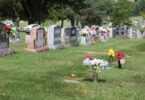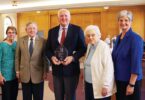by Joe Bollig
joe.bollig@theleaven.org
She wanted to join the Ursuline Sisters of Paola, a teaching order.
But she didn’t want to teach.
So Sister Susanne Bauer, OSU, cooked and cleaned in the motherhouse for seven years until another Sister became sick. She reluctantly agreed to fill in for her, but only for three days.
And she discovered that she loved to teach.
Years later, Sister Susanne was asked to become a principal in Oklahoma.
“The last placed I wanted to go was Oklahoma,” she said.
And she loved it so much she stayed for 18 years.
Now, Sister Susanne is being asked to do something else she doesn’t want to do: Say goodbye to the Ursuline motherhouse in Paola forever. But like those earlier changes in life she didn’t ask for, she’s facing this latest one with faith and an open mind.
“It involves a lot,” she said. “To me, it’s going to be a new adventure. I don’t know what lies ahead, but I’ll look forward to it, whatever it is.
“But at the same time, I’ll always treasure what I had here at Ursuline of Paola.”
Faced with a declining number of Sisters and the burden of upkeep for their grand motherhouse, the Ursuline Sisters of Paola decided to merge with the Ursuline Sisters of Mount Saint Joseph in Maple Mount, Ky. On Oct. 21, 2008 — the feast of St. Angela Merici — it became official.
The Sisters still haven’t found a buyer for the buildings and 36.5 acres of land. But whether or not it is sold, almost all of the Ursuline Sisters will leave the former motherhouse, now temporarily a convent, sometime this summer.
This act will, in a practical way, end the 114-year history of Ursuline Sisters in Paola.
A bold, new vision
The Ursuline tradition of strong, visionary women began with the foundress herself — St. Angela Merici, who was born in 1474 in the region of Lombardy, Italy.
Saint Angela came of age with the closing of the Renaissance and the beginning of the Protestant Reformation. She strongly believed that educated women would produce strong and faithful families, and thus build a firm foundation for society. This conviction was confirmed when she experienced a vision of St. Ursula, a fourth-century virgin and martyr who educated other women in the Scriptures.
Saint Angela decided to found an order under the patronage of St. Ursula that would offer a radically new vision of religious life, very unlike what had come before.
First, it would not be founded as a counterpart of a male religious order. Second, it would not be monastic; the Ursulines would live with their own families and go out into the world. Third, the early Ursulines did not wear habits. Saint Angela knew the world was changing rapidly, and she established these fundamentals to help the Sisters adapt to the needs of the times. Thus, the Ursuline charism was established.
Soon the number of Ursulines grew and began to spread all over Europe, and then to North America.
A bold act of faith
The Paola Ursulines trace their lineage to Ursulines who came from Straubing, Germany, and established a foundation in Louisville, Ky., in 1858. Later, the Louisville Ursulines established a house in St. Louis.
As with ethnic Catholic communities elsewhere in the United States, these German-speaking Sisters directed their ministry to German-speaking parishes.
In time, the American-born Ursulines sought to break away from the German language, culture, and ways, so they could minister to the broader English- speaking community.
In 1893, a group of dissenting Louisville Sisters, without the permission of their superior, accepted an invitation from Archbishop Peter Richard Kenrick to come to St. Louis. While he was visiting St. Louis, Bishop Louis M. Fink of the Diocese of Leavenworth also invited the Sisters to come to Scipio to teach in the parish school.
These breakaway Ursulines struggled to establish themselves in St. Louis and Shelbyville, Ky. Kansas was no different. Two Ursuline Sisters came to Scipio in 1894 and discovered, even at that late date, Kansas offered plenty of pioneer hardships.
“The country is most beautiful and picturesque, but, oh! It is not St. Louis,” wrote Sister Maurice Albert in an August 1894 letter to the Shelbyville Ursulines. She further wrote: “Do all you can by Bishop (John Joseph) Kain (archbishop of St. Louis from 1895 to 1903) and do not take a step for here before you have seen this place.”
The Ursulines ultimately decided, however, that their future awaited them in Kansas. Scipio was too small, so they investigated different locations in the Diocese of Leavenworth before deciding on Paola.
The dynamic century
Sister Maurice Albert and Sister Jerome Schaub arrived in Paola on Dec. 8, 1894. Two prominent non-Catholic Paolans, approving of the Sisters’ plans to open an academy, raised funds for them to buy land. Construction began the next summer. Bishop Fink appointed Sister Jerome to be the superior of the order.
The academy opened its doors to the boys and girls of Paola on March 1, 1896. The Ursulines planned on waiting to take in boarders, but one night, soon after the school opened to day students, a Native American woman came to the Ursulines’ door. She begged the Sisters to take care of her two little sons because she couldn’t. Overnight, the academy became a boarding school as well.
The ensuing years brought more growth and struggle. During five of the early years there were no graduating classes. In 1902, Bishop Fink intervened to break a tie for election of a new superior, which led to a split in the community. Fifteen Sisters returned to Louisville or left religious life entirely, and only six Ursulines of Paola remained. However, by 1917, the order had grown to 49 Sisters.
Over the years the Ursulines taught in many parish schools of the Diocese of Leavenworth (later the Archdiocese of Kansas City in Kansas). Eventually, the Sisters expanded to schools in Missouri, Oklahoma, California, Illinois, Ohio and California. Eventually, the St. Louis and Shelbyville houses were closed.
But the Paola campus continued to grow. A second building was built in 1904. The original motherhouse was added on to in 1905, an auditorium was built in 1916, and a large, new administration building (now the former motherhouse) was built in 1926.
In the early years the Ursulines’ grade school served both boys and girls, but the academy was all-girl. Some were from Paola and others were boarding students. At its peak, the academy had 100 boarders. The academy had an international program that drew students from Latin America, Europe, and Asia.
The two-year junior college, established in 1924, was also all female. Enrollment was never high, and the largest junior college graduating class was 21 in 1935. During its history, however, exceptions were made for two men to attend classes.
Many of the Sisters taught several grades and often as janitors as well as teachers. As late as the 1980s, they didn’t receive salaries — just meager stipends, most of which went to support the order.
Because many of the Sisters came from the small towns and farms of the archdiocese, they were used to hard work and self-sufficiency. They kept livestock and a large garden. During the Great Depression and World War II, they were able to raise rabbits to feed themselves and their students.
Saint Angela wanted her Sisters to be flexible and responsive to the needs of people, so when many mothers began to work at nearby war production factories, the Ursulines even offered child care.
Change and evolution
The post-World War II era saw, perhaps, the peak years for the Ursuline Sisters of Paola. Nevertheless, the Sisters were forced by declines in enrollment and changing education requirements to close their grade school in 1946, the junior college in 1957, the summer camp in 1967, and the academy in 1971.
Sister Mary Charles McGrath, elected superior in 1956, led the Ursulines beyond their traditional classroom ministry, partly in response to the changes introduced by the Second Vatican Council, which lasted from 1962 to 1965.
During the ’60s and ’70s, the Ursulines established a community food pantry, a se- nior citizens center, a foster grandparents program, and the Lakemary Center for chil- dren with developmental difficulties.
Other Sisters began to serve as hospital chaplains, home health care workers, and in parish ministry. And while they were involved in these, the Ursulines continued to teach in several archdiocesan schools.
Making the life-giving choice
The Ursulines were never a large religious order, but they managed nevertheless to produce truly impressive accomplishments. Even a willing spirit, however, must bow to demographic realities.
Just prior to the Second Vatican Council, the Ursulines of Paola numbered about 150. By 1970, their numbers had declined to about 100 and to 46 by 1995. Finally, by the time of the merger, the order was comprised of 23 Sisters. The median age of the Sisters began to rise, and the youngest and most vital members were pulled away from ministries to undertake administrative duties.
In the meantime, over the years, Ursuline landmarks were razed, including the old motherhouse and Brescia Hall in 1985 and the summer camp in 1989.
The Ursulines of Paola could have simply tapered off and disappeared, as some orders have chosen to do. Through much discussion, prayer and discernment, the Ursulines chose instead to merge with a Sister congregation: They chose life.
This doesn’t mean the end of an Ursuline presence in this area. Sister Kathleen Condry, the local coordinator, and Sister Helen Smith will stay until the property is sold.
Eight of the former Paola Ursulines will continue their ministries in this area as Ursulines of Mount St. Joseph: four in the Kansas City area, and one each in Lawrence, Richmond, Emporia and Maryville, Mo. One Sister from Kentucky is interested in moving to Kansas, and it’s possible that others might follow her.
And of course, the 110 laypeople who are members of the Ursuline Associates will continue to be active in the archdiocese.
One could point to many things as being part of the legacy of the Ursuline Sisters of Paola — all the schools they helped open and operate, the Lakemary Center and various programs in Paola they supported or founded, and the former motherhouse itself.
But there are also intangible things.
“I’d like to think that our strongest legacy is our contribution to the strength of family life in the archdiocese,” said Sister Kathleen.
“All the buildings, institutions, parishes and schools are wonderful things that we helped promote, but our real focus has always been — and will continue to be — to help bring God’s love to all people, especially through strengthening family life. . . . We call it helping people to know, love, and serve God.”
“We are very grateful to all the people of the archdiocese,” she continued. “We’ve had a long history of wonderful support for anything we’ve tried to do, not only from parishioners but also the pastors and the bishops we have worked with.”
“Our time in the archdiocese,” she concluded simply, “has been very happy.”






